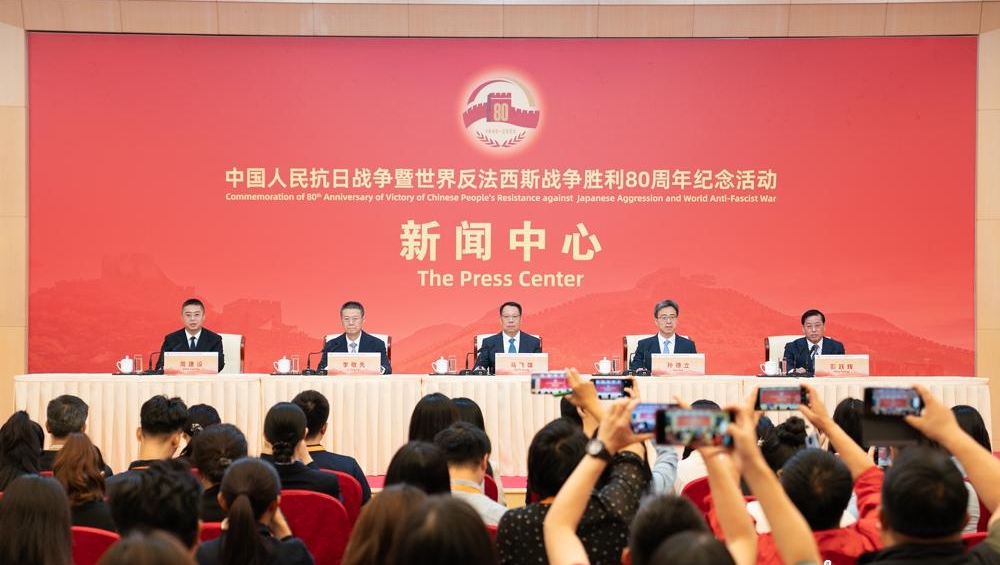Elephant News:
Cultural relics related to the resistance war against Japanese aggression are not only a shared historical memory for all humanity, but also an important carrier of the great spirit forged during the war. How can we tell the stories of the resistance war well by leveraging cultural relics from that period and promote the spirit of resisting aggression? Thank you.
Sun Deli:
Thank you for your question. General Secretary Xi Jinping highly values revolutionary history and has always held revolutionary cultural relics in high regard and with deep affection. During many inspections and research trips, he paid tribute to revolutionary sites and martyrs, repeatedly urging that the revolutionary cultural relics be well protected, managed, and utilized. On July 7 this year, as China marked the 88th anniversary of the start of the entire nation's resistance against Japanese aggression, General Secretary Xi Jinping made a special visit to the monument square honoring the martyrs of the Hundred-Regiment Campaign in Yangquan, Shanxi province, to lay a floral basket in tribute to the martyrs of the Eighth Route Army, and then visited an exhibition at the Memorial Hall of the Hundred-Regiment Campaign. On this sacred land where our Party led the military and civilians to fight bravely, it carries special and profound significance to revisit the glorious history, honor the martyrs, call for keeping the stories of resistance alive, and promote the great spirit of resisting aggression.
Cultural relics related to the resistance war contain rich stories and embody the great spirit of resisting aggression. We will thoroughly study and implement the important instructions of General Secretary Xi Jinping, fully carrying out the protection and utilization of cultural relics related to the resistance war. We will investigate the rich connotations and educational functions of the wartime relics, share the touching stories from the war, and promote the great spirit of resisting aggression, to pool our strength and forge ahead in unity.
I think, first, we need to leverage the role of cultural relics from the resistance war in providing evidence-based interpretation of history, using accurate historical facts and scientific conclusions to educate and enlighten people. Cultural relics are visible and tangible history. Historical photos and precious artifacts bear silent witness to the heinous and inhumane crimes committed by the Japanese militarists during the war. They also provide a vivid portrayal of the glorious history of the CPC leading the military and civilians in a united resistance against Japanese aggression with unwavering courage. They are a testament to our Party's role as the pillar of the entire nation throughout the war. We will further strengthen the historical research on the wartime relics, sift through historical details, restore the original historical landscape, and deeply reveal the development process and principles of victory in the resistance war. Not only that, but we will further enhance the exhibition level of wartime relics, delve into content development, strive for innovation of display methods, and guide people to form a correct understanding of history and deeply learn from historical lessons.
Second, we will narrate the touching stories behind the war relics, using the heroic deeds and shining images to inspire and enlighten people. Cultural relics are vivid and authentic, offering direct insights into historical events and figures. Among them are steel helmets of the garrison troops during the Lugou Bridge Incident housed in the Museum of the War of Chinese People's Resistance Against Japanese Aggression, the saber used by hero Yang Jingyu exhibited in the Museum of the Communist Party of China, the brocade banner inscribed with "Assault Company of the Battle of Pingxingguan" on display at the Pingxingguan Victory Memorial Hall, and the robe stained with the blood of patriotic overseas Chinese leader Yi Guangyan when he was killed, displayed in the Overseas Chinese History Museum of China. Behind each of these precious cultural relics are touching stories and shining original aspirations. We will actively guide the storytelling and detailed presentation of these war relics, enhancing the expressiveness and emotional impact of the exhibitions. By vividly telling the stories behind the relics, presenting multidimensional and lifelike images of heroes, we aim to promote respect for heroes, encourage people to learn from them, and inspire others to aspire to emulate their heroism.
Third, we will interpret the spiritual essence embodied by the war relics, using the grand spirit and honorable traditions they convey to motivate and uplift people. These cultural relics represent a deep accumulation of the Chinese nation's cultural spirit, breadth and confidence. In the Museum of the War of Chinese People's Resistance Against Japanese Aggression, there is a manuscript titled "Camping Song" written by a Northeast United Resistance Army soldier. He writes: The north wind roars, the heavy snow flies. The warhorses hesitate, their steps uncertain; the biting cold makes sleep elusive through the night. Warmth radiates from the fire heating our chests, yet our backs remain chilled by the wind. Brave men! With utmost sincerity and vigor, we sweep across the Nenjiang Plain." When seeing this, some museum goers exclaimed, "Such spirit, such fervor, how genuine and bold! How could such a team not advance! How could they possibly be suppressed!" This is the inner strength of the war relics that directly touches people's hearts and moves them. We will organize solemn, ceremonious and engaging events to vividly display the timeless and ever-renewing spirit of the great resistance. These events are designed to ignite patriotic fervor, harness energy for progress, and inspire people to unite and strive toward the comprehensive advancement of national development and the grand cause of national rejuvenation. Thank you.


 Share:
Share: 




 京公網(wǎng)安備 11010802027341號(hào)
京公網(wǎng)安備 11010802027341號(hào)